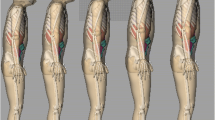Summary
In order to assess human organ doses for risk estimates under natural and man made radiation exposure conditions, human phantoms have to be used. As an improvement to the mathematical anthropomorphic phantoms, a new family of phantoms is proposed, constructed from computer tomographic (CT) data. A technique is developed which allows any physical phantom to be converted into computer files to be used for several applications. The new human phantoms present advantages towards the location and shape of the organs, in particular the hard bone and bone marrow. The CT phantoms were used to construct three dimensional images of high resolution; some examples are given and their potential is discussed. The use of CT phantoms is also demonstrated to assess accurately the proportion of bone marrow in the skeleton. Finally, the use of CT phantoms for Monte Carlo (MC) calculations of doses resulting from various photon exposures in radiology and radiation protection is discussed.
Similar content being viewed by others
References
Synder WS, Ford MR, Warner GG, Fisher SB (1969) Estimates of absorbed fractions for monoenergetic photon sources uniformly distributed in various organs of a heterogeneous phantom. MIRD Pamphlet No 5. J Nucl Med 10 [Suppl], No 3
Synder WS, Ford MR, Warner GG (1974) Estimates of absorbed fractions for monoenergetic photon sources uniformly distributed in various organs of a heterogeneous phantom; Revision of MIRD Pamphlet No 5. ORNL-4979
Kramer R, Zankl M, Williams G, Drexler G (1982) The calculation of dose from external photon exposures using reference human phantoms and Monte Carlo methods. Part I: The male (Adam) and female (Eva) adult mathematical phantoms. GSF-Report S-885
Cristy M (1980) Mathematical phantoms representing children of various ages for use in estimates of internal dose. Oak Ridge National Laboratory, ORNL/NUREG/TM-367
Drexler G, Panzer W, Widenmann L, Williams G, Zankl M (1984) The calculation of dose from external photon exposures using reference human phantoms and Monte Carlo methods. Part III: Organ doses in X-ray diagnosis. GSF-Report S-1026
Rosenstein M (1976) Organ doses in diagnostic radiology. Bureau of Radiological Health, Rockville, Maryland. HEW publication (FDA) 76-8030
Rosenstein M, Thomas JB, Warner GG (1979) Quantification of current practice in pediatric roentgenography for organ dose calculations. Bureau of Radiological Health, Rockville, Maryland. HEW publication (FDA) 79-8078
Wall BF (1986) Risk estimation in patient dosimetry techniques in diagnostic radiology. Institute of Physical Sciences in Medicine, United Kingdom
Williams G, Zankl M, Drexler G (1984) The calculation of dose from external photon exposures using reference human phantoms and Monte Carlo methods. Part IV: Organ doses in radiotherapy. GSF-Report S-1054
Petoussi N, Zankl M, Williams G, Veit R, Drexler G (1987) The calculation of dose from photon exposures using reference human phantoms and Monte Carlo methods. Part V : Organ doses from radiotherapy for cervical cancer. GSF-Report 5/87
Williams G, Zankl M, Eckerl H, Drexler G (1985) The calculation of dose from external photon exposures using reference human phantoms and Monte Carlo methods. Part II: Organ doses from occupational exposures. GSF-Report S-1079
International Commission on Radiological Protection (1975) ICRP Publication 23. Reference man: Anatomical, physiological and metabolic characteristics. Pergamon Press, Oxford
Mannweiler E, Rappl W, Abmayr W (1982) Software for interactive Biomedical image processing-BIP. Proceedings of the 6th International Conference on Pattern Recognition. IEEE Computer Society Press, New York, p 1213
Christiansen HN, Sederberg TW (1977) MOVIE BYU, a general purpose computer graphics display system. Proceedings of the Symposium on Application of Computer Methods in Engineering. University of Southern California, L.A. 759–769
Cristy M (1981) Active bone marrow distribution as a function of age in humans. Phys Med Biol 26:389–400
Wright JB, Roussin RW (1979) Photon interaction data DLC-7F. Radiation Shielding Information Center. Oak Ridge National Laboratory
Birch R, Marshall M (1979) Computation of Bremsstrahlung X-ray spectra and comparison with spectra measured with a Ge(Li) detector. Phys Med Biol 24:505–517
Author information
Authors and Affiliations
Additional information
Dedicated to Prof. W. Jacobi on the occasion of his 60th birthday
Rights and permissions
About this article
Cite this article
Zankl, M., Veit, R., Williams, G. et al. The construction of computer tomographic phantoms and their application in radiology and radiation protection. Radiat Environ Biophys 27, 153–164 (1988). https://doi.org/10.1007/BF01214605
Received:
Accepted:
Issue Date:
DOI: https://doi.org/10.1007/BF01214605




